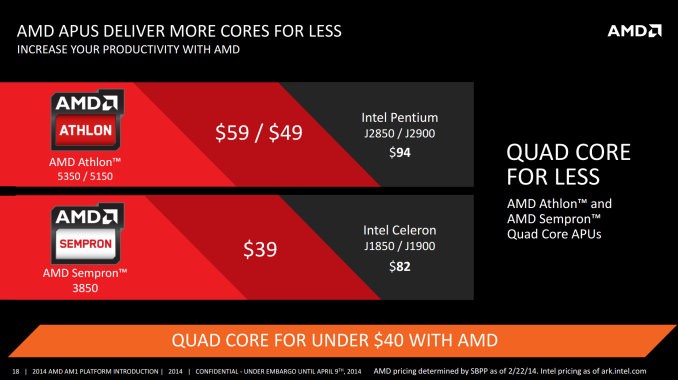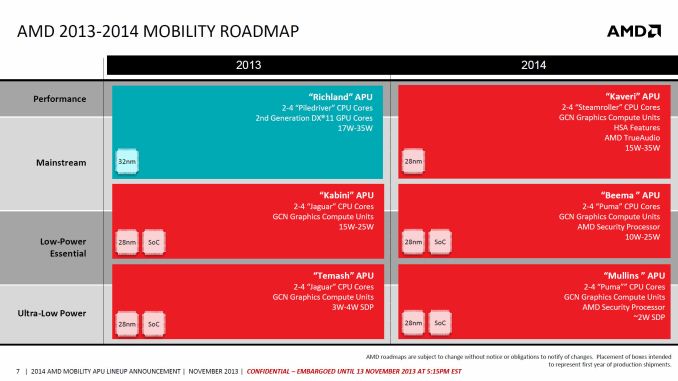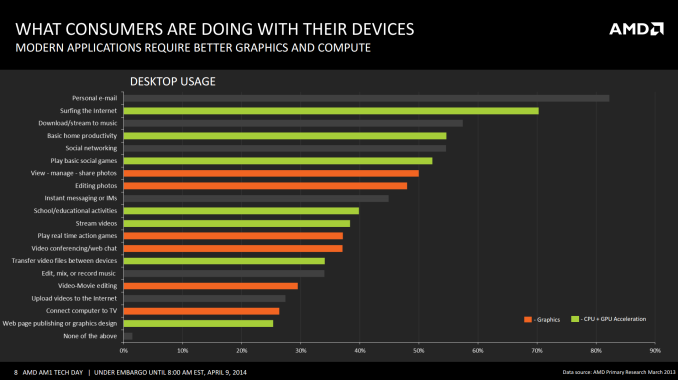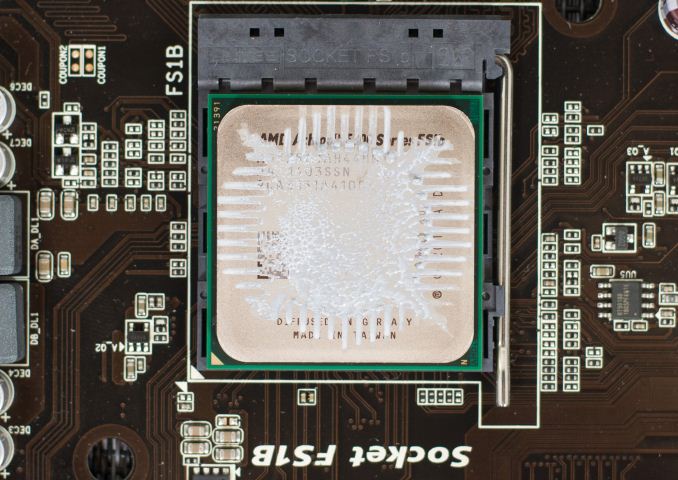The Desktop Kabini Review Part 1: AMD Athlon 5350 (AM1) Tested
by Ian Cutress on April 9, 2014 8:00 AM ESTFinal Words
As mentioned in our test setup, the benchmark results in this preliminary article are only a small fraction of our normal coverage. Due to other commitments we were unable to run every test on all comparison systems, but we have the other Athlon and Sempron APUs as well as comparable Intel counterparts coming in for review.
The poignant place to start with the final analysis is AMD’s claim of ‘Quad Core for Less’. In this statement alone, they are not wrong. Intel cannot provide a socketed quad core processor for less than $36 (Sempron 3850). The cheapest all-in-one desktop quad-core system from Intel equips the Celeron J1900 onto a motherboard for $92, which is exactly where AMD sit with the top-end Kabini based Athlon 5350 with a motherboard. One of the issues to consider at this point however is that Intel offers several dual core options (non-Atom) around this $40-$60 price point, and in many cases the IPC and CPU speed advantage of these cores is greater than that provided by Kabini, particularly in single threaded applications. The only downsides to this solution are the power consumption is higher, and the motherboards are more expensive. For a competitive socketed Intel dual core, a motherboard plus CPU can be in the region of $110-$120 at 35W-55W.
The big upside and selling point from the AM1 Kabini platform should be upgradeability. If a user buys an AM1 platform now, they should be able to upgrade it in the future. While AMD has not yet confirmed if Beema is coming to the socketed platform, the roadmaps suggest that the laptop sockets are remaining consistent from Kabini to Beema. This should imply that if Beema gets a socketed version, it should also remain based on AM1/FS1b.
If we compare single threaded performance between Kabini and our J1800 test system, the benchmarks are almost even between the two, particularly when it comes to synthetics such as Cinebench, but falls behind on emulation such as the Dolphin Benchmark and 3DPM. The integrated graphics of the Kabini pull ahead when it comes to gaming, despite the single channel memory interface.
|
AMD Athlon 5350 vs. Intel Celeron J1800 Single Threaded |
||
| Athlon 5350 | Celeron J1800 | |
| Cinebench R10 | 1967 | 1917 |
| Cinebench R11.5 | 0.51 | 0.49 |
| Dolphin Benchmark | 40.4 | 38.02 |
| 3DPM | 53.29 | 69.20 |
When placing Kabini against any Intel Ivy Bridge socketed processor, the increased IPC and frequency pushes the system above the Kabini, in exchange for more power and a more expensive system overall. If we compare the Kabini single-threaded results to those of the Celeron G465, a Sandy Bridge based single core CPU at 1.9 GHz, the Celeron does pull ahead on the majority, but fails miserably in the graphical benchmark suite.
|
AMD Athlon 5350 vs. Intel Celeron G465 Single Threaded |
||
| Athlon 5350 | Celeron G465 | |
| Cinebench R10 | 1967 | 2975 |
| Cinebench R11.5 | 0.51 | 0.73 |
| Dolphin Benchmark | 40.4 | 38.8 |
| 3DPM | 53.29 | 59.98 |
Does it seem particularly odd that a modern Kabini architecture at 2 GHz cannot keep up with a 3 year old Sandy Bridge processor at 1.9 GHz at our simple benchmarks? AMD is leveraging on the fact that much of what we do on a computer as a casual user can leverage the fixed function units of the graphics center of the APU:
AMD’s key in all of this is leveraging the GPU. For non-GPU intensive tasks, on paper, the J1900 for $92 and 10W TDP would seem to be the choice if upgradability is not a concern. The remit of AM1 and Kabini could be extended if motherboard manufacturers decided to use those extra PCIe lanes. Consider an AM1 with controllers to make a nice routing system (4x NIC) or something based around storage (SATA controllers and hubs). But because Kabini is also a cost play for AMD at the low-end desktop segment, margins are going to be ultra-tight for motherboard manufacturers and I do not imagine that as much effort will be put into making innovative products as the rest of their product range on other sockets.
In order for the upgradability angle to work, AMD need to keep the sockets around for at least two generations. AM1 comes late in Kabini’s life cycle, given that Beema on the mobile side is due out later in 2014. It would make sense for AMD to release Beema desktop parts, but the big question there is when. AMD could launch new processors on day 1 of Beema, or further into the life cycle. I would imagine that depends on what the competition does. AMD does have that advantage of having an upgradeable platform before Intel; however Intel may see the market differently. It is a hard one to judge.
Stay tuned for our full benchmark suite on the other AMD Kabini APUs.














126 Comments
View All Comments
tomsworkshop - Friday, April 11, 2014 - link
i think these chips are nice for 12"-13" slim laptop, and don't if it is soldered on board, is about time they replace the current E350 APU on mobo with jaguar core chips, maybe the GDDR5 sideport memory onboard will be a nice feature.Hrel - Friday, April 11, 2014 - link
I don't even know why they're bothering, these performance numbers are useless.Oscarcharliezulu - Saturday, April 12, 2014 - link
PC's wont compete with tablets by being cheap, they compete by being awesome - 4k screens, fast ssd's, great 3d graphics, cloud storage so you can work anywhere, great games at ultra HD....hangfirew8 - Monday, April 14, 2014 - link
...and a full-sized keyboard and mouse.Antronman - Monday, April 21, 2014 - link
Microsoft solved that problem.Heck, some of the Surface tablets have serious CPU computing power.
PCs compete by having better price/performance, and yes being generally better.
I'd like to see UE4 on an iPad air :P
plonk420 - Sunday, April 13, 2014 - link
on my 19 watt E-350 (microATX, also see http://www.anandtech.com/show/4996/ ), i removed the tiny, possibly whiny fan, and secured a PWM 120mm Arctic Cooling fan over it. that with a PC Power and Cooling Silencer, and it was so quiet, i could hear my fridge and other PCs around the apartment, it was so quiet.fteoath64 - Sunday, April 13, 2014 - link
How could a dual core chip clocked at less than 1.5Ghz with gpu at 400Mhz have a TDP of 25 watts ?!!!. Even an Arm chip clocked at 1.9Ghz have a TDP of about 5 watts. How can x86 compete really in terms of price performance and power ?!. These are throw away chips with such power consumption levels.0ldman79 - Sunday, April 13, 2014 - link
Any way we could get some FX processors in the benches?I know that AM3+ is probably a dead line, but we've still got the machines out in the world. I'd like to know where my PC lines up without having to find an FX 6300 compared to a Core i5 compared to an A8.
payton2037 - Sunday, April 13, 2014 - link
Start a Second Income™with the company that's first with Internet entrepreneurs!For more Details Please visit at :--
http://www.sfi4.com/14161637/FREE
duploxxx - Monday, April 14, 2014 - link
And yet again we have to find out that in the conclusion the review start to focus on cpu performance only and compairing with totally different types of cpu to make this kabini look bad especially the single threaded performance. while it is on par with latest generation of intel or on multithreaded way better.http://www.anandtech.com/show/7933/the-desktop-kab...
not a single word in the conclusions on graphics which again shows how bad all these intel parts really are... even these latest generations.
I often wonder that reviewer background and how neutral they actually are and look at a certain system from a certain perspective, sure my ferrari will run faster then a fiat, but look at the purpose and design...